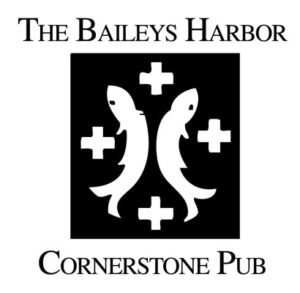Baileys Harbor’s Spot for Gas and Gatherings
- Share
- Tweet
- Pin
- Share
Back in the day, men used to gather ’round the potbelly stove in the general store to drink coffee and share news (and quite likely chew tobacco and spit, which their wives didn’t permit at home). With the general stores long gone, the need for a gathering place still exists. In Baileys Harbor, it’s been supplied for decades by the gas station at 7998 Hwy. 57.
The earliest records available in the courthouse indicate that the original owners of that bit of ground were Thomas and Mary McCullough, who purchased it on April 4, 1885. Greg Orsted remembers that the first gas station appeared on the site about 1930. At that time, the gas sold was Socony – an acronym for Standard Oil Company of New York, a spin-off of Rockefeller’s original Standard Oil Company that had been broken up by the anti-trust act of 1911.

Ownership passed through many hands in the next few decades – Tom and Elizabeth Collins, George Messer, Anna and William Toft (Emma’s older brother and the Baileys Harbor postmaster from 1918 to 1939), George and Helen Gerdman, and Alfred, Charlotte, Arthur and Marie Koser.
The “modern” era began in 1978, when Art Koser died and the station passed to his stepson, Fredrick Nelson. “Fast Freddy” was the colorful owner for 18 years. Since then, owners have included Katherine Farrell and Cameron, Barbara, Scott and Nancy Isaacson.
In 1964, the station burned to the ground and was rebuilt. Before that fire, Art Koser had added an auto body shop to the back of the station. As it was burning he was inside, frantically trying to save equipment. Ten years later, it burned again, but the auto repair shop that had been added to the south side sustained only smoke damage. Freddy added the “back view” section of the station soon after he bought it. In 1980, he hired Orsted to run the auto shop, which he did until he injured his back. For a while, Freddy’s son, Chuck, sold Cub Cadet lawn tractors in the former shop, then Freddy bought the stock of the “old” grocery store in town, operated by Carol Moroney, and moved it to the space adjoining the gas station.
Freddy and his wife, Rosemary, lived in a house on the north side of the station that was later moved to the far north end of town. Freddy continued selling Mobil gas (the successor to Socony) out front, but also installed holding tanks and self-service pumps on the site where the house had been and sold what he called “fast gas.”
When Kathy Farrell bought the station in 1998, she added the apartments upstairs. Since 2003, the gas at the station has been Citgo.

Art Koser
So many tales and memories associated with the station have accumulated through the years. Will Anschutz, who grew up on the dairy farm where Stone’s Throw Winery is now located, remembers that, in the mid-1940s, the old Lutheran church on the hill rewarded children who attended Sunday school with money to buy a comic book at the station afterwards. Freddy remembers that kids from the religion class at the Catholic church used to skip out and come to the station to play cards for money, making sure they were back at the church by the time their folks came to pick them up. Art Koser got into trouble for allowing gambling on the premises.
Carol Gauger Goss remembers that Marie Koser, her hair secured in a headscarf, always pumped gas with a cigarette hanging from her lips. The late Betty Gauger and Mary and Catherine Collins were responsible for the first seating arrangement at the station. Faithful daily attenders at mass in Baileys Harbor, they always treated themselves afterward with donuts and coffee at the Fast Stop. Although the wall of windows Freddy had installed on the east side of the back room provided a wonderful view of the lake, there was nowhere to sit inside and enjoy it. A garage sale card table and chairs the women installed solved that problem for themselves and others. Orsted recalls that there was nothing else open in those days and that a banquet table was added for a morning coffee klatch that sometimes drew nearly a dozen.

Fredrick Nelson
Some people have probably supposed that the “fast gas” Freddy sold was the source of his nickname, but he says it came from the fact that he never turned down a job. “Whenever someone needed something done,” he says, “people would say, ‘Take it to Fast Freddy. He’ll get around to it.’ And it always got done.”
Everyone who was around in the Fast Freddy era remembers the coat made from 180 neckties by Darlene Meyer and her daughter that he wore in July 4th parades. That was just one example of Freddy’s colorful wardrobe. “I never bought any clothes all the time I had the gas station,” he said recently. “Whatever someone wanted to get rid of, I’d wear. I ended up with about 3,000 ties, and I always wore a jacket and tie to work. I definitely wanted to put a little color in the world. If something matched, I’d made a mistake.”
When he sold the station, the leftover ties went to a sewing circle in Sturgeon Bay.
Freddy says he never missed a day of work in 20 years – always there at 6 am. The donuts people enjoyed at the station came from a bakery in Algoma. Freddy arranged for Bob Bennett, who worked the feed mill in Baileys Harbor, but lived in Algoma, to pick them up every morning.
Besides his colorful wardrobe, the thing most people remember about the Fast Freddy era is the battle over the sign in front of the station that had been in the same location since Gerdman owned it. In 1988, when Mobil wanted to implement a “new image” at the station at considerable expense to Freddy, he switched to Union 76. According to a lengthy piece titled The End of a Sign, published by Freddy, the county planning board first told him there would be no problem with putting up a new sign as long as the size did not exceed 24 square feet.
Months later, he received a letter saying he had six signs out of compliance and 30 days to fix the problem. After seven hearings, the result was that the sign remained, but Freddy wrapped it in plastic, rendering it a “non-sign.” It stood for four or five years, swaddled in turn in camouflage, orange, blue and green plastic. “Yeah, it was covered,” Freddy says, “but when it was lighted at night, you could still read it.”

Freddy lives in Jacksonport now. He says he moved when Baileys Harbor put in sidewalks.
In February of this year, Michael Schreiber of Lake Forest, Ill., became the owner of the station, newly christened Baileys 57. Part of a third generation with family ties on Ridges Road, Schreiber’s business is buying, upgrading and selling commercial property like strip malls. New managers of the station are Kari Weisgerber Bauman and Eric Williams.
Bauman says that she and Schreiber, longtime friends, had often talked about going into business together. “He considered a restaurant,” she says, “but I’d had enough of that growing up at Cornerstone. I was ready to get out of the restaurant business and he was ready to get into the gas business. It appealed to both of us. Eric has worked at the station for a long time, as well as the Town of Baileys Harbor, so he’s well acquainted with the community.”
The new management team, assisted by Bauman’s mother, Sandy Weisgerber, spent two weeks cleaning and renovating and reopened for business on March 9. There’s new shelving in the expanded grocery area, and fresh produce, Victor Allen coffee, packaged meats from Marchant’s, bakery goods from Pink Bakery and Piggly Wiggly and pickled asparagus, salsa, jalapeños and jams “to die for,” from Sammi Rae’s Homemade. There are plans to apply for a license that will allow the station to open a soup and sandwich deli in the future. At present, all the food sold has to be packaged or prepared off-site.
Nearly every morning, a number of people congregate there to buy newspapers and catch up on local news. Definitely no tobacco chewing or spitting. And in the area where the three little ladies set up their card table and chairs years ago – there are now four tables that invite customers to enjoy a donut, coffee and a panoramic view of the lake and Anclam Park Beach. On a recent morning, the tables were occupied by eight men and four women. There are six nice picnic tables outside by the water.
Summer hours are 6 am to 9 pm daily. In the winter, they’ll close at 7 pm.



